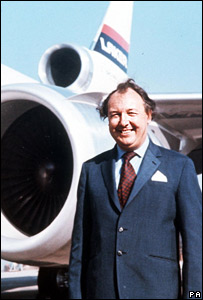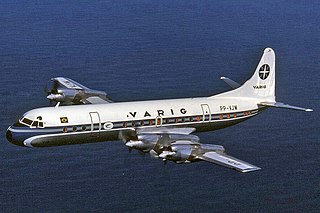
Silver City Airways was an airline, based in the United Kingdom, that operated mainly in Europe, between 1946 and 1962. Unlike many airlines at the time, it was independent of government-owned corporations; its parent company was Zinc Corporation, an Australian company involved mainly in mining and mineral processing. The name "Silver City" originated as a nickname of Broken Hill, Australia – an area famed for silver mines, including some owned by the airline's parent company.

Sir Frederick Alfred Laker was an English airline entrepreneur, best known for founding Laker Airways in 1966, which went bankrupt in 1982. Known as Freddie Laker, he was one of the first airline owners to adopt the "low cost / no-frills" airline business model that has since proven to be very successful worldwide with companies such as Norwegian Air, Ryanair, easyJet, AirAsia and WestJet.

Blackbushe Airport is an operational general aviation airport in the civil parish of Yateley in the north-east corner of the English county of Hampshire. Built during the Second World War, Blackbushe is north of the A30 road between Camberley and Hook. For a time, it straddled this road with traffic having to wait whilst airliners were towed across. The south side was used for aircraft maintenance, using wartime-built hangars. Today, only the part of the airfield that lay north of the A30 remains in active use. The historical name for the flat piece of land on which it is sited is Hartford Bridge Flats. The nearest towns are Yateley and Fleet.

London Southend Airport is an international airport situated on the outskirts of Southend-on-Sea in Essex, England, approximately 36 miles (58 km) from the centre of London. The airport straddles the boundaries between the city of Southend-on-Sea and the Rochford District.

The Lockheed L-188 Electra is an American turboprop airliner built by Lockheed. First flown in 1957, it was the first large turboprop airliner built in the United States. Initial sales were good, but after two fatal crashes that led to expensive modifications to fix a design defect, no more were ordered. With its unique high power-to-weight ratio, huge propellers and very short wings, large Fowler flaps which significantly increased effective wing area when extended, and four-engined design, the airplane had airfield performance capabilities unmatched by many jet transport aircraft even today—particularly on short runways and high field elevations. Jet airliners soon supplanted turboprops for many purposes, and many Electras were modified as freighters. Some Electras are still being used in various roles into the 21st century. The airframe was also used as the basis for the Lockheed P-3 Orion maritime patrol aircraft.
This is a list of aviation-related events from 1958:

The Handley Page HP.81 Hermes was a civilian airliner designed and produced by the British aircraft manufacturer Handley Page.

Dan-Air was an airline based in the United Kingdom and a wholly owned subsidiary of London shipbroking firm Davies and Newman. It was started in 1953 with a single aircraft. Initially, it operated cargo and passenger charter flights from Southend (1953–1955) and Blackbushe airports (1955–1960) using a variety of piston-engined aircraft before moving to a new base at Gatwick Airport in 1960, followed by expansion into inclusive tour (IT) charter flights and all-year round scheduled services. The introduction of two de Havilland Comet series 4 jet aircraft in 1966 made Dan-Air the second British independent airline after British United Airways to begin sustained jet operations.

British United Airways (BUA) was a private, independent British airline formed as a result of the merger of Airwork Services and Hunting-Clan Air Transport in July 1960, making it the largest wholly private airline based in the United Kingdom at the time. British and Commonwealth Shipping (B&C) was the new airline's main shareholder.

Airwork Limited, also referred to during its history as Airwork Services Limited, is a wholly owned subsidiary company of VT Group plc. It has a long and rich history in providing a variety of defence support services to the Royal Air Force (RAF), Fleet Air Arm and overseas air forces, as well as having played an important role in the development of civil aviation – both in the United Kingdom and abroad.

British Eagle International Airlines was a major British independent airline that operated from 1948 until it went into liquidation in 1968. It operated scheduled and charter services on a domestic, international and transatlantic basis over the years.
ACE Freighters was a British cargo airline from 1964 to 1966.

Trans European Aviation was a British charter airline which operated from 1954 until closure in 1963. With the introduction of the larger Lockheed Constellation to its services, the airline name was changed in 1961 to Trans European Airways.
British Aviation Services Limited (Britavia) was an early post-World War II airline holding company and air transport operator that could trace its roots back to 1946. Its main activities included trooping, inclusive tour (IT) and worldwide passenger and freight charter services. British Aviation Services' first investment in a British independent airline occurred in 1946, when it acquired a minority interest in Silver City Airways. Silver City Airways operated the world's first cross-Channel air ferry service on 13 July 1948. It subsequently became British Aviation Services' biggest operating division. In 1953, British Aviation Services took over the independent airline Air Kruise. The same year, BAS Group also took control of Aquila Airways, the last commercial flying boat operator in the United Kingdom. The completion of these acquisitions by mid-1954 resulted in a reorganisation of the British Aviation Services group, with British Aviation Services Ltd becoming the group's holding company and Britavia one of its operating subsidiaries. By the late 1950s, BAS Group became Britain's largest independent airline operator. Its numerous operating divisions included Britavia's Hermes Division at Blackbushe Airport and Aquila Airways's Flying Boat Division at Hamble near Southampton. The former concentrated on trooping services and inclusive tours while the latter provided scheduled services to Portugal, the Canary Islands and Italy. In 1962, BAS Group merged with British United Airways (BUA), which by that time had replaced BAS as the UK's largest independent airline operator.
Transair Limited was an early post-World War II private, independent British airline formed in 1947. It began as an air taxi operator at Croydon Airport. In 1953, it started inclusive tour (IT) charter flights. By 1957, Transair became part of the Airwork group. The following year it shifted its operating base and headquarters to Gatwick Airport. In 1960, Transair was absorbed into British United Airways (BUA), as a result of the Airwork — Hunting-Clan merger.
Skyways Limited was an early post-World War II British airline formed in 1946 that soon became well-established as the biggest operator of non-scheduled air services in Europe.
Air Safaris was a British scheduled and charter airline from 1959 to 1962.

British Overseas Airways Corporation (BOAC) was the British state-owned airline created in 1939 by the merger of Imperial Airways and British Airways Ltd. It continued operating overseas services throughout World War II. After the passing of the Civil Aviation Act 1946, European and South American services passed to two further state-owned airlines, British European Airways (BEA) and British South American Airways (BSAA). BOAC absorbed BSAA in 1949, but BEA continued to operate British domestic and European routes for the next quarter century. A 1971 Act of Parliament merged BOAC and BEA, effective 31 March 1974, forming today's British Airways. For most of its history its main rival was Pan Am.
Gatwick Airport was in Surrey until 1974, when it became part of West Sussex as a result of a county boundary change. The original, pre-World War II airport was built on the site of a manor in the parish of Charlwood. The land was first used as an aerodrome in the 1920s, and in 1933 commercial flights there were approved by the Air Ministry.












